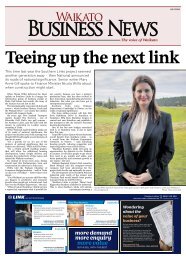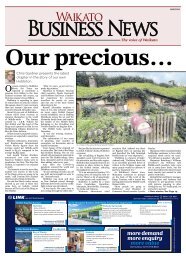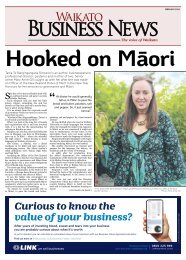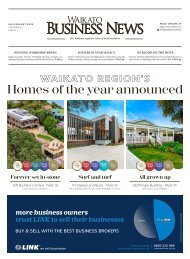Waikato Business News March/April 2023
Waikato Business News has for a quarter of a century been the voice of the region’s business community, a business community with a very real commitment to innovation and an ethos of co-operation.
Waikato Business News has for a quarter of a century been the voice of the region’s business community, a business community with a very real commitment to innovation and an ethos of co-operation.
Create successful ePaper yourself
Turn your PDF publications into a flip-book with our unique Google optimized e-Paper software.
26 VIBRANT CAMBRIDGE<br />
WAIKATO BUSINESS NEWS, MARCH/APRIL <strong>2023</strong><br />
PAUA Architects:<br />
Shaping Cambridge for over 25 years.<br />
Architect Antanas Procuta has been contributing to and<br />
helping to shape the town he calls home for over 25 years.<br />
Initially working from home in<br />
Cambridge, Procuta was joined early<br />
on by architect Richard Mauriohooho,<br />
who recently celebrated 25 years with<br />
the practice. Long-standing team<br />
members have been a strength of the<br />
practice, with architect Geoff Lentz<br />
also marking 20 years this February.<br />
Despite taking up premises in<br />
Hamilton in 2001 and completing<br />
projects across the <strong>Waikato</strong>, the<br />
practice has maintained strong roots<br />
in Cambridge, with both Procuta and<br />
strategic development manager Phil<br />
Mackay based in the Town of Trees.<br />
The practice has played an important<br />
part in shaping the town, with past<br />
work including the masterplanning of<br />
the Cambridge Park subdivision, the<br />
urban and architectural design of Le<br />
Quesnoy Place townhouse enclave,<br />
residential homes, and the recently<br />
completed Cambridge Police Hub.<br />
The common theme running through<br />
these projects is the importance<br />
of local context, with each project<br />
acknowledging and building on the<br />
unique character of Cambridge.<br />
In Procuta’s words: “The focus of<br />
our design is the individual, crafted<br />
response to the site, to the client and<br />
to their brief.”<br />
Cambridge Park<br />
In 2003 PAUA was engaged to<br />
prepare the overall urban concept<br />
and masterplan for a 330-household<br />
residential subdivision – now known<br />
as Cambridge Park.<br />
The neighbourhood is centred on a<br />
public green space at the heart of the<br />
community and designed to continue<br />
the original 1863 arcaded street<br />
design for Cambridge. The road and<br />
pedestrian walkway layout references<br />
this grid pattern to prioritise<br />
pedestrian activities through the<br />
neighbourhood. In 2009 the project<br />
won the Living Streets Aotearoa<br />
‘Golden Foot Award’ for Walkability.<br />
Le Quesnoy Place<br />
PAUA was approached in 2004 by<br />
a local developer wanting to build<br />
on the unique character legacy of<br />
Cambridge.<br />
Inspired by Cambridge’s sister-city<br />
relationship with Le Quesnoy in<br />
France and occupying an enviable<br />
location on the banks of the <strong>Waikato</strong><br />
River, the neighbourhood comprises<br />
fifteen, high-quality, two-storey<br />
homes designed to complement<br />
each other with similar architectural<br />
forms, materials and features.<br />
Papillon Townhouse<br />
Built for a local farming couple, this<br />
townhouse was designed around the<br />
conceptual idea of creating courtyard<br />
spaces and a sense of spaciousness<br />
within a smaller site. This idea<br />
prompted the ‘papillon’, or butterfly,<br />
shaped layout of the floor plan.<br />
A traditional architectural form was<br />
chosen to link with neighbourhood<br />
church buildings and houses in what<br />
is one of the earlier-settled areas of<br />
Cambridge. Local materials such as<br />
Hinuera stone were chosen alongside<br />
other high performing materials<br />
to craft a contemporary home that<br />
respects the context of the local area.<br />
Cambridge Police Hub<br />
The architectural brief was to provide<br />
a design that reflected the new<br />
approach in New Zealand policing<br />
and acknowledged the nature of the<br />
collaborative partnership between<br />
<strong>Waikato</strong>-Tainui and the NZ Police in<br />
this development.<br />
Reflecting on the importance of water<br />
in Māori culture, Senior Architect<br />
Richard Mauriohooho based the<br />
shape of the building on a Waka<br />
Hourua, or double hulled waka.<br />
The orientation of the building<br />
also makes reference to local<br />
maunga - Maungatautari, Pirongia,<br />
Maungakawa, and Kakepuku -<br />
through the alignment of walls and<br />
windows, while local materials were<br />
used in keeping with <strong>Waikato</strong> Tainui<br />
strategies.<br />
As well as the prominent Hinuera<br />
stone wall featuring a ‘niho taniwha’<br />
pattern, recycled wood and bricks<br />
from the police house previously on<br />
the site have been used as features in<br />
the new building, connecting to the<br />
history and context of the site.<br />
CAMBRIDGE POLICE HUB<br />
Procuta<br />
Associates<br />
Urban +<br />
Architecture<br />
07 839 6521<br />
www.pauaarchitects.co.nz


















